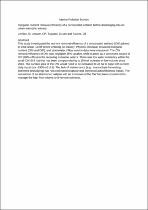 ResearchSpace
ResearchSpace
Inorganic nutrient removal efficiency of a constructed wetland before discharging into an urban eutrophic estuary
JavaScript is disabled for your browser. Some features of this site may not work without it.
- ResearchSpace
- →
- Research Publications/Outputs
- →
- Journal Articles
- →
- View Item
| dc.contributor.author |
Lemley, D

|
|
| dc.contributor.author |
Lekane, CP

|
|
| dc.contributor.author |
Taljaard, Susan

|
|
| dc.contributor.author |
Adams, JB

|
|
| dc.date.accessioned | 2022-06-22T07:08:43Z | |
| dc.date.available | 2022-06-22T07:08:43Z | |
| dc.date.issued | 2022-06 | |
| dc.identifier.citation | Lemley, D., Lekane, C., Taljaard, S. & Adams, J. 2022. Inorganic nutrient removal efficiency of a constructed wetland before discharging into an urban eutrophic estuary. <i>Marine Pollution Bulletin, 179.</i> http://hdl.handle.net/10204/12438 | en_ZA |
| dc.identifier.issn | 0025-326X | |
| dc.identifier.issn | 1879-3363 | |
| dc.identifier.uri | https://doi.org/10.1016/j.marpolbul.2022.113727 | |
| dc.identifier.uri | http://hdl.handle.net/10204/12438 | |
| dc.description.abstract | This study investigated the nutrient removal efficiency of a constructed wetland (CW) piloted to treat urban runoff before entering an estuary. Physico-chemical, dissolved inorganic nutrient (DIN and DIP), and stormwater inflow volume data were measured. The CW removal efficiency of DIN was negligible (5% uptake), while it acted as a consistent source of DIP (68% efflux) to the receiving estuarine waters. There was low water residency within the small CW (0.8 ha) that has been compounded by a 10-fold increase in flow volume since 2016. The surface area of the CW would need to be increased to 46 ha to cope with current daily inputs (ca. 6300 m3 d-1). The lack of maintenance (e.g., macrophyte harvesting, sediment desludging) has reduced nutrient uptake and increased autochthonous inputs. The conversion of an abandoned saltpan into an extension of the CW has been considered to manage the high flow volume and remove nutrients. | en_US |
| dc.format | Abstract | en_US |
| dc.language.iso | en | en_US |
| dc.relation.uri | https://pubmed.ncbi.nlm.nih.gov/35537307/ | en_US |
| dc.source | Marine Pollution Bulletin, 179 | en_US |
| dc.subject | Emergent macrophytes | en_US |
| dc.subject | Eutrophication | en_US |
| dc.subject | Nitrogen | en_US |
| dc.subject | Stormwater management | en_US |
| dc.subject | Typha capensis | en_US |
| dc.title | Inorganic nutrient removal efficiency of a constructed wetland before discharging into an urban eutrophic estuary | en_US |
| dc.type | Article | en_US |
| dc.description.pages | 6 | en_US |
| dc.description.note | © 2022 Elsevier Ltd. All rights reserved. Due to copyright restrictions, the attached PDF file only contains the abstract of the full text item. For access to the full text item, please consult the publisher's website: https://doi.org/10.1016/j.marpolbul.2022.113727 | en_US |
| dc.description.cluster | Smart Places | en_US |
| dc.description.impactarea | Coastal Systems | en_US |
| dc.identifier.apacitation | Lemley, D., Lekane, C., Taljaard, S., & Adams, J. (2022). Inorganic nutrient removal efficiency of a constructed wetland before discharging into an urban eutrophic estuary. <i>Marine Pollution Bulletin, 179</i>, http://hdl.handle.net/10204/12438 | en_ZA |
| dc.identifier.chicagocitation | Lemley, D, CP Lekane, Susan Taljaard, and JB Adams "Inorganic nutrient removal efficiency of a constructed wetland before discharging into an urban eutrophic estuary." <i>Marine Pollution Bulletin, 179</i> (2022) http://hdl.handle.net/10204/12438 | en_ZA |
| dc.identifier.vancouvercitation | Lemley D, Lekane C, Taljaard S, Adams J. Inorganic nutrient removal efficiency of a constructed wetland before discharging into an urban eutrophic estuary. Marine Pollution Bulletin, 179. 2022; http://hdl.handle.net/10204/12438. | en_ZA |
| dc.identifier.ris | TY - Article AU - Lemley, D AU - Lekane, CP AU - Taljaard, Susan AU - Adams, JB AB - This study investigated the nutrient removal efficiency of a constructed wetland (CW) piloted to treat urban runoff before entering an estuary. Physico-chemical, dissolved inorganic nutrient (DIN and DIP), and stormwater inflow volume data were measured. The CW removal efficiency of DIN was negligible (5% uptake), while it acted as a consistent source of DIP (68% efflux) to the receiving estuarine waters. There was low water residency within the small CW (0.8 ha) that has been compounded by a 10-fold increase in flow volume since 2016. The surface area of the CW would need to be increased to 46 ha to cope with current daily inputs (ca. 6300 m3 d-1). The lack of maintenance (e.g., macrophyte harvesting, sediment desludging) has reduced nutrient uptake and increased autochthonous inputs. The conversion of an abandoned saltpan into an extension of the CW has been considered to manage the high flow volume and remove nutrients. DA - 2022-06 DB - ResearchSpace DP - CSIR J1 - Marine Pollution Bulletin, 179 KW - Emergent macrophytes KW - Eutrophication KW - Nitrogen KW - Stormwater management KW - Typha capensis LK - https://researchspace.csir.co.za PY - 2022 SM - 0025-326X SM - 1879-3363 T1 - Inorganic nutrient removal efficiency of a constructed wetland before discharging into an urban eutrophic estuary TI - Inorganic nutrient removal efficiency of a constructed wetland before discharging into an urban eutrophic estuary UR - http://hdl.handle.net/10204/12438 ER - | en_ZA |
| dc.identifier.worklist | 25755 | en_US |





